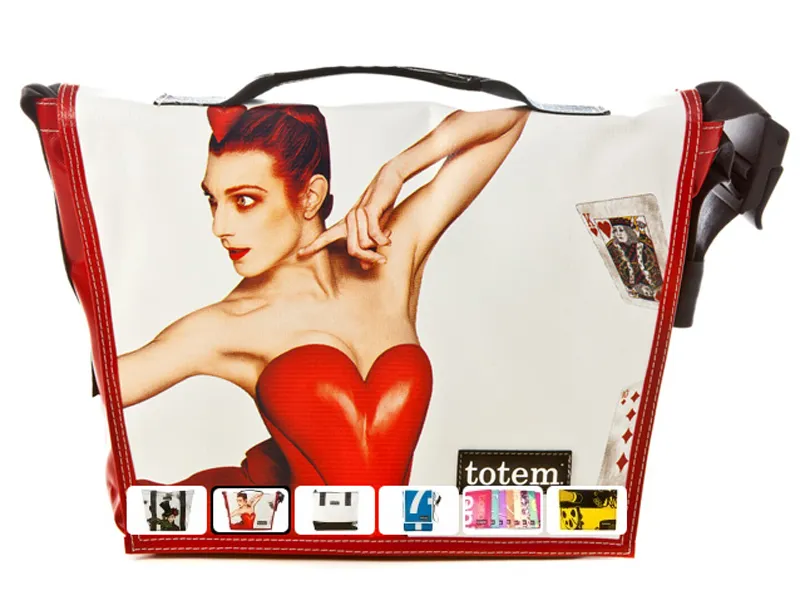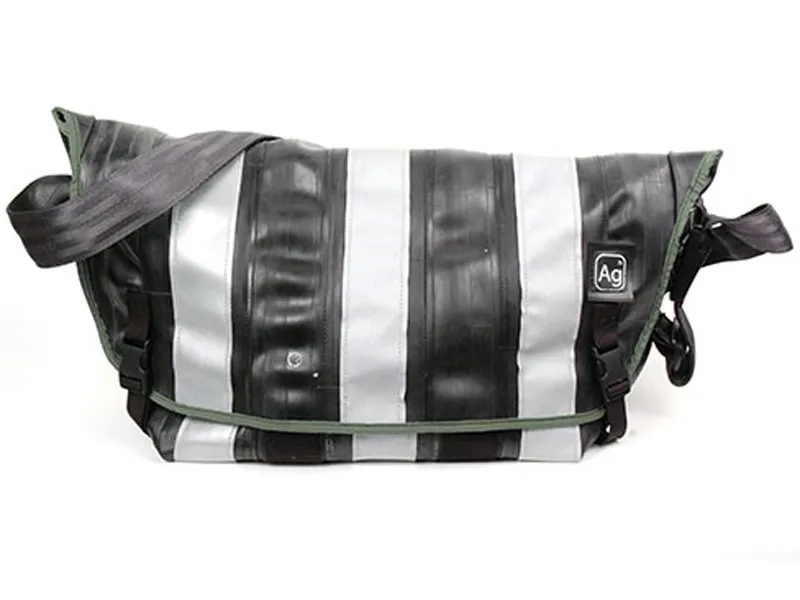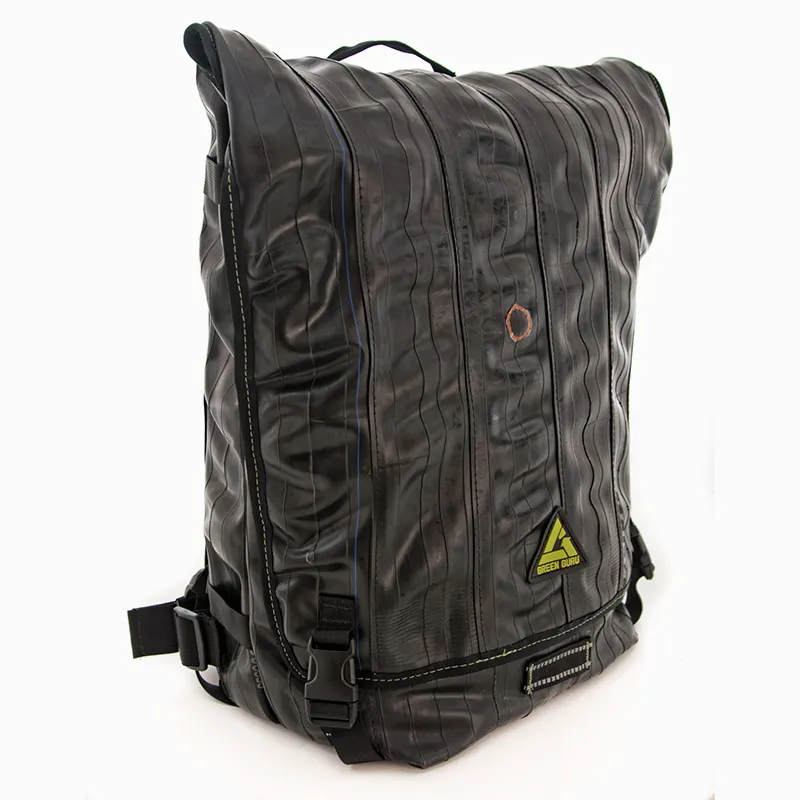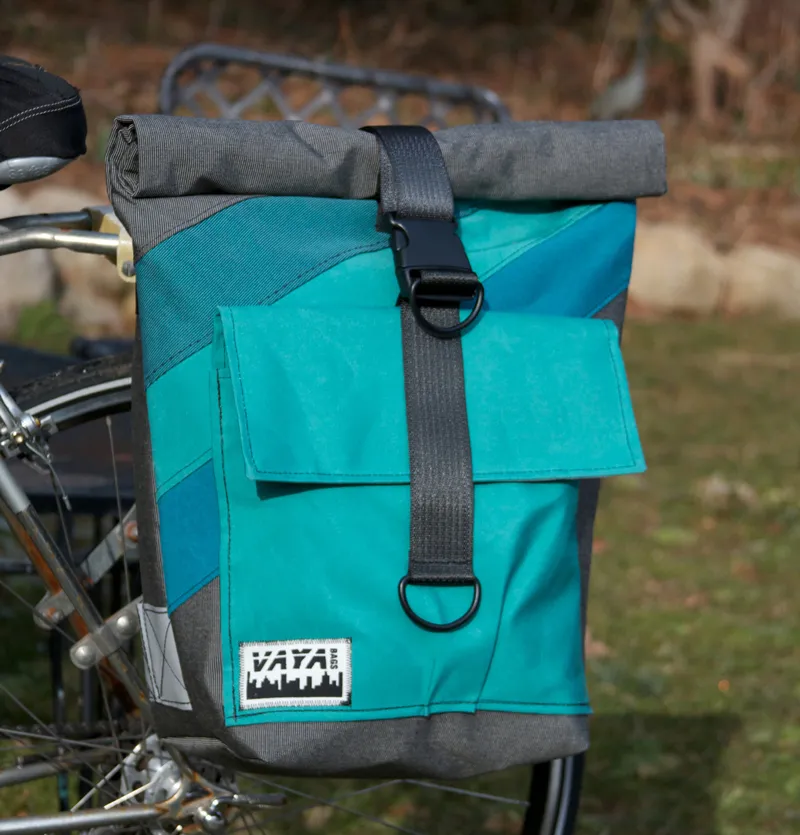While recycling is commonplace these days, an increasing number of companies are making businesses out of “upcycling,” where used materials are reformed into something new. Whereas recycling often involves middlemen that reduce old material back to a state similar to the virgin material, upcycling takes the old material in its current form and reshapes it. In the cycling world, this often means bags made out of old inner tubes and finds new approaches.
Thus there are upstarts and enterprise businesses that are taking what would otherwise end up in a landfill and transforming it into a new product. This trend is being seen to a great extent in North America with bags. Across the continent a few innovators are apparently thinking alike, taking old vinyl billboards and finding new uses with it. Epicstoke of Minneapolis and Rareform of Los Angeles are taking the vinyl and making ski and surf-board bags, respectively. In Toronto, Totem Bags is also looking at using billboards and other ad-based banners and turning it is shoulder bags. What makes all of these bags stand out is that each is truly unique.

Totem produce perhaps the most fashion-forward upcycled bags
“Every product is unique and every bag has a story, a history,” said Melissa Richardson, founder and owner of Totem Bags. “We all have a story, like the Johnny Cash song, ‘I've been everywhere...’”
Richardson told BikeRadar that acquiring the materials is often the easy part, and it allows her company to do its part to ensure that these disposed of materials don’t simply end up in the landfill.
“Our materials are locally sourced from wreckers, bikes shops and banner companies, all of which are looking for ways to be nicer to the environment,” she added. “We are minimizing waste one bag at a time and creating something that is hip, street smart and cool and that every bag owner can carry with pride.”
Totem is also looking beyond just billboards, Richardson noted. “All of our products are hand cut from upcycled materials including street pole banners, truck tarp, seat belts and bicycle inner tubes," she said.
In fact, one of the most common areas of upcycling in the world of cycling is to find new uses for inner tubes. While some riders will patch a tube until it is seemingly more patch than original tube, many will simply discard a tube that has a single puncture. The downside to this is that the rubber isn’t exactly the easiest material to recycle, and while there are aftermarket uses, several companies have taken the same approach as Totem in finding new ways to use that old tube.

Vays Bags, in New York, makes a variety of products from upcycled materials
In Boulder, Colorado, Green Guru makes backpacks, panniers, wallets and more from discarded materials.
In Brooklyn, New York, Vaya Bags uses various scrap and surplus materials, including canvas that is acquired from local sailboat factories, but the company has increased its use of bike tubes, much of which is acquired locally.
“We get all of our recycled bike tubes from local bike shops in Brooklyn, Manhattan, New Jersey and Long Island,” said Angie Boylan of Vaya Bags. “They throw the tubes in a box for us when they change a flat instead of throwing them out.”
In addition Vaya Bags now has customers and friends also saving tubes. And as with Totem Bags, they find treasure where others might just find trash.
“We also get old banners from the botanical garden or the local YMCA,” Boylan told BikeRadar. “We get scrap sailboat awnings from boat awning manufacturers on Long Island. About 50 percent of our material are recycled or scrap and they include bike tubes, scrap sailboat awnings and old banners.”

Vaya Bags began in 2009
For Vaya no tube is the wrong size either.
“We actually use all types and sizes of bike tubes,” said Boylan. “The bigger mountain bike tubes are used on bags and the small road bike tubes we use for belts and smaller accessories. We are not picky and will take any tubes that are being thrown out.”
The fact that numerous companies are now doing the same thing could suggest that this is a trend, but those involved see it as more of the new norm rather than just the next thing. While trends have a tendency to last until the next thing after that comes along those who are serious about upcycling believe this will stick around.
“It's definitely a new way of thinking and not necessarily a ‘trend,’” said Luke F. Brown, director of sales and marketing at Alchemy Goods, a bag maker in Seattle, Washington, that also sees gold in old bike tubes.
Alchemy Goods has upcycled some 300,000 tubes to date and encourages shops and customers to keep sending them tubes.

Alchemy Goods bags are made in Seattle
“People are starting to think really critically about where their products come from, who makes them, and from what kind of material,” Brown told BikeRadar. “Alchemy Goods gets a lot of attention in these areas because we’re made in Seattle, and we utilize reclaimed bike tubes as our primary raw-material. Customers are becoming more and more critical in the way they shop for products, especially products with a higher purchase price.”
“With reclaimed and recycled goods, nearly every industry from health care to food production are thinking about reducing waste, recycling and even more recently ‘upcycling,’” he added. “In most cases they discover cost savings they didn’t even expect.”
Brown also explained that upcycling has clear benefits over even traditional recycling as it takes what is otherwise useless in current form and finds a new use for it, rather than trying to transform the actual material – something that commonly happens with used rubber from tires and tubes. This could include grinding car tires down into pellets that become additives for asphalt pavement.
The bags provide an alternative because it takes the materials in the existing raw form and allows it to remain so into a new product.

Green Guru's new Ruckus backpack
“We promote ‘upcycling’ because it’s actually taking a raw material and without changing its physical state, turning it into something more valuable,” he added. “Recycling can mean a variety of things, but most commonly means a raw material goes through a process of re-manufacturing and energy input to end up in a different form."
This isn’t to say that consumers should turn their backs on products that are actually made of recycled materials as well. Some manufacturers are seeing that both can be used – and in some cases not everything can be so readily “upcycled.”
Bag and accessory maker Timbuk2 has gone Full-Cycle with its new brand of recycled/upcycled bags. These feature fabrics and webbing that come from recycled plastic bottles, while the straps and buckles are made from post-industrial and post-consumer materials.
“Sourcing and production are some of the great challenges of new, innovative reuse scenarios,” said Timbuk2’s brand director Lizzy Fallows. “Recycling materials to make a new fabric can be toxic, result in weaker materials, or its benefit can be outweighed by the transit and processing energy required to make the new material. Timbuk2’s stance is we will not use a new material, regardless of its content, if it compromises our durability standards, because we feel the ‘most’ sustainable thing to do is to make products that last. If products truly last, less waste is created in the churn of constantly buying new products.”
Fallows said that upcycling/recycling is not necessarily connected to local sources and outputs. Regardless of where the materials are from it still comes down to energy, costs and whether the resulting product is durable and safe to use for the long haul.
Similarly, Alchemy's Brown said his company tries to look at the whole lifespan of a material.
“There are a lot of things that are billed as ‘green’ that are not necessarily sustainable when you consider all of the energy inputs,” said Brown. “We focus on bike tubes and truck tubes, and keeping those raw materials out of the landfills - even though it would probably be easier and more cost effective for us to utilize virgin materials. But, when we have such a great, durable and abundant raw material right here to take advantage of, we don’t need to. Our model is to always try to maximize the recycled and upcycled content in our finished products, and to do everything possible to source the balance of the raw materials we utilize locally.”
